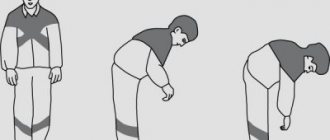Think about it and honestly tell yourself how susceptible you are to stress and how well do you deal with it? Identifying symptoms such as fatigue at the beginning of the working day, irritation, impatience, insomnia, anxiety over any little things, and anxiety in general will help clarify the answer. Do you often hear the phrase from friends and family: “It’s time for you to rest and relax,” but do not react to such remarks? If you easily recognize yourself in the previous sentences, it’s time to learn how to relieve tension through relaxation exercises.
And if this topic seems interesting to you and you want to develop even more in it, we recommend our course “Mental Self-Regulation”, where you will learn real practical techniques for self-motivation, stress management and social adaptation in order to always control your emotional and mental state. Find out more about the course
In the healthy lifestyle training, we wrote about some ways to combat the negative effects of stress that modern people are constantly exposed to in their lives. In this article, we have collected some popular techniques and exercises for relieving tension. They can easily be practiced at home, without having experience in such endeavors. The given sets of exercises are suitable for both children and adults. In addition, they are varied and based on popular breathing techniques and muscle relaxation training that are widely practiced today.
Relieving tension
For many of us, relaxation is rest at the end of a busy day. And for most people it happens the same way – in front of a TV screen or a home computer monitor. But this is far from the best way to relieve emotional stress; rather, it is a kind of illusion of relaxation. The senses remain in working order - you experience emotions, worry. From a physiological point of view, this method is not suitable for dealing with stress, because in order to fully restore mental strength, you need to activate the body’s natural relaxation reaction. There are special techniques for this (yoga, qigong, tai chi, Zen), but even without knowledge of them, you can, by devoting some free time to practice every day, learn to cope with anxiety and depression, control anger, and avoid many diseases of the cardiovascular and nervous systems. The sets of exercises given below are built taking into account accessibility and feasibility, and include elements of yoga, meditation practices, and breathing exercises. Remember that you can improve their results by using relaxation techniques along with physical exercise and ensuring proper rest through healthy sleep.
As you begin to practice various relaxation techniques, remember the following. Learning the basics of relaxation techniques is not difficult, but it does take time and some effort. Most experts recommend exercising at least 10-20 minutes a day. Those attending special sessions to relieve stress spend 30-60 minutes. Start small, and individual elements of the exercises can be performed right at your desk, in transport, at a bus stop.
Top 3 ways to relieve tension:
Relaxing massage
It has been used since ancient times to relieve tension. However, even in our time it is a relevant and best way to combat back discomfort. In order for the massage to be performed correctly, several rules must be followed:
- Choose a comfortable environment in which you can relax your whole body.
- Use various oils, mixtures, creams. Massage is performed only on the naked part of the body.
- It is not recommended to take breaks; changing techniques should occur smoothly.
- The duration of the massage should not exceed 25 minutes.
- It is necessary to start and end a relaxing massage with elements of stroking;
- Before the procedure, do not eat for at least 60 minutes.
The master's hands should always be warm. The first session lasts no more than 10 minutes
The main techniques are stroking, rubbing, kneading, patting and vibration. You should not use a lot of force, movements should be smooth and slow.
Complex 1. Breathing exercises
Deep breathing allows you to relax, regardless of the thoughts that overcome a person. It is not for nothing that in films, when police or doctors arrive at the scene, they advise victims to first of all breathe deeply and evenly. In stressful situations, breathing quickens and the body lacks oxygen. Deep breathing promotes the flow of this vital gas into the brain and all cells in the required volumes.
Exercises:
- Inhale and exhale slowly and deeply through your nose, counting from 1 to 4 as you inhale and exhale. This exercise is very easy to do, and it is especially effective if you cannot sleep.
- Try relaxing your shoulders and upper chest muscles as you breathe. Do this consciously with each exhalation. The fact is that in stressful situations, when a person is tense, the diaphragm muscles are not used for breathing. Their purpose is to lower the lungs down, thereby expanding the airways. When we are excited, the muscles of the upper chest and shoulders are more often used, which do not contribute to the full functioning of the respiratory organs.
- Nadi Shodhana. A yoga exercise that helps you become more active and focused; According to experts, it acts like a cup of coffee. With the thumb of your right hand, you need to close the right nostril and inhale deeply through the left (for women, use the thumb of your left hand to close the left nostril and inhale through the right). At the peak of inhalation, you need to close your left (right for women) nostril with your ring finger and exhale through your mouth.
- Sit up straight or lie on your back. Place one hand on your stomach, the other on your chest. Inhale air deeply through your nose, while the hand on your stomach should rise and the hand on your chest should move only slightly. Exhale through your mouth, while the hand on your stomach again drops, and on your chest practically does not move. In this case, breathing will occur using the diaphragm.
Medicines
Used only when the pain becomes unbearable. Medicines such as muscle relaxants perfectly relieve spasms of skeletal muscles, eliminating the cause of pain. The most famous and best remedy that does not have a sedative effect is Mydocalm. It is allowed even for children from 3 years of age.
If the above methods do not relax the muscles, then you need to contact a specialist for help as soon as possible. There may be serious abnormalities that require medical intervention.
Complex 2. Muscle relaxation
The progressive muscle relaxation technique was developed by the American doctor E. Jacobson in the 1920s. It is based on a simple physiological fact: after tension of any muscle, a period of automatic relaxation begins. Taking this into account, a technique was developed according to which, in order to achieve deep relaxation of the body, you first need to strongly tense your muscles for 10-15 seconds, and then concentrate on the feeling of relaxation that arises in them for 15-20 seconds.
Exercises:
- Start by focusing on your breathing for a few minutes. Breathe slowly and calmly, think about something pleasant. After this, you can begin muscle exercises, working on different muscle groups.
- Hands.
Squeeze your hand as tightly and tightly as possible. You should feel tension in your hand and forearm. Relax your hand as you exhale, concentrating on the feeling of relief that arises. Repeat the same for the other hand. If you are right-handed, you should start with your right hand, if you are left-handed, start with your left. - Neck.
Tilt your head back, slowly turn it from side to side, then relax. Pull your shoulder joints high towards your ears and in this position tilt your chin towards your chest. - Face.
Raise your eyebrows as high as possible, open your mouth wide (as if you are pretending to be very surprised). Close your eyes tightly, frown and wrinkle your nose. Clench your jaw tightly and move the corners of your mouth back. - Breast.
Take a deep breath and hold it for a few seconds, then relax and return to normal breathing. - Back and stomach.
Tighten your abdominal muscles, squeeze your shoulder blades together and arch your back. - Legs.
Tighten the front and back muscles of your thighs, keeping your knee in a tense, bent position. Pull your foot towards you as much as possible and straighten your toes. Extend your ankle joint and flex your toes.
Do 3-4 repetitions of the complex. Each time you rest a newly tense muscle, notice how good it feels and how relaxed you feel. It helps many people cope with stress and anxiety.
5+ effective exercises to relax your back and neck muscles
- "Starfish".
Starting position – lying on your back, arms to the sides. Sit on a flat, hard surface. Try to relax as much as possible. Then begin twisting to the side, with your upper torso and arms moving one way and your lower body moving the other. After this, return to the starting position and twist in the opposite direction. Take your time and don't overexert yourself.
- "Lying stone"
This is a good exercise to relax the muscles of the neck, shoulders and back, helping to improve blood circulation throughout the body. To complete this you will need a mat and a chair. The latter is installed with the seat towards the rug at its very edge. It is necessary to lie on your back so that your legs are bent with your shins lying on the chair. Your hips should be at right angles to the floor. Lie like this for three to four minutes, and then perform several swings with straight arms, trying to reach the floor behind your head with your hands.
Experts at the Witch's Happiness store recommend:
Regardie Israel, A Guide to Relaxation for Lazy People. Second Edition: Deep Relaxation for Health and Calmness
145 ₽
buy
Northern incense “Moonlight” (sticks) Herbal incense sticks without essential oils
330 ₽
buy
Soap "Fields of Anvil" with lavender Soothes and disinfects
350 ₽
buy
- "Flexible snake"
Starting position – lying on your stomach, arms supported at shoulder level. Using your hands, slowly lift your upper body. Be careful: your feet rest on your toes. Feel the tension in the muscles of your legs and abdomen, but do not cause discomfort. Return to the starting position. It is advisable to perform at least ten repetitions. This way you will take care of your spine, protecting it from the effects of daily stress or sedentary work. You can also use this exercise to relax your arm muscles.
- "Embryo".
The fetal position is considered to be the most comfortable and physiologically correct, since it is this position that is established by nature when the fetus is inside the mother. An adult relaxes much faster in it and restores his strength and peace of mind. Starting position - on your back, legs bent and pulled to your stomach with your hands. Lie like this for a minute. Return to the starting position, then do the exercise while lying on your side (first on one side, then on the other). Repeat several times.
- "Corner".
This exercise to relax the muscles of the lower back and back is performed near a sofa or soft chair. You need to stand behind the back of the furniture and, leaning over it, hang there for several minutes. In this case, the lower abdomen rests on the back, and the toes are on the floor. During the exercise, the body should be bent at a right angle and the arms folded on the chest.
- "Legs Braiding"
Starting position - lying on your back with your legs bent at the knees and your feet resting on the floor. Grasp your right leg with your hands and rotate it, bringing your shin under the knee bend of your left leg. Slowly pull your legs towards your stomach with your hands until the shin of your left leg is horizontal in the air. Hold the pose for about 30 seconds, then repeat on the other limb. At least eight repetitions are required for each leg.
Regular muscle tension can cause spasms that will bother you for many years. When blood vessels and nerve fibers are pinched, many internal organs and the brain begin to experience a lack of oxygen and nutrients, which negatively affects human health.
Articles recommended for reading:
- How to recover from stress
- Feng Shui sectors - Eastern wisdom for your well-being
- Meditation to restore energy
Performing exercises to relax the abdominal and back muscles does not require much time and effort. It is enough to accustom yourself to daily exercise, and then you will be able to overcome many different health problems. Chronic migraine, intercostal neuralgia, decreased vision and other pathologies will recede if you exercise regularly. Physical activity and water procedures in combination can significantly increase a person’s ability to work and improve his mood.
Complex 3. Meditation
The most general definition of the concept of “meditation” in psychological dictionaries is: “a method of mental training in which intense, penetrating reflection occurs, immersion in an object, an idea, which is achieved by concentrating on one object.” The recommendations collected in this block concern how to conduct a visual meditation session on your own. Visual meditation is a variation of traditional meditation that is based on the use of not only visual meanings, but also the senses: taste, touch, smell and sound. When used as a relaxation technique, visualization involves imagining a scene in which you feel free from tension and anxiety.
Set of exercises:
- Choose a quiet and secluded place, with nothing to distract you. Find a comfortable position. It is not recommended to lie down; it is better to sit on the floor, in a chair, or try sitting in the lotus position.
- Select a focal point. It can be internal - an imaginary scene, or external - a candle flame. Therefore, the eyes can be open or closed. At the beginning, it is very difficult to concentrate and avoid distracting thoughts, so the focus point should have a strong meaning, understandable and clear, so that you can return to it at any time.
- The focal point should definitely be something calming for you. It could be a tropical beach at sunset, a forest clearing, or an orchard in a village near your grandparents’ house, where you visited as a child. Visual meditation can be done in silence, or you can turn on relaxing music or an audio recording with meditation tips.
- Try to use all your senses as much as possible. For example, your focal point is a forest. Imagine that you are walking through a clearing, and cold dew falls on your feet, you hear the singing of many birds, smell the pine, breathe in the clean air deeply. The picture should be as lively as possible. Meditate for 15-20 minutes.
Remember, relaxation will not save you from problems, but it will help you relax and distract yourself from unimportant details, so that later you can tackle the solution with renewed vigor.
Reviews and comments
You can express your opinion about the article, relaxation exercises, as well as share your own knowledge on the topic and experience, using the comment form.
We also recommend reading:
- Storytelling
- Muscle relaxation: relaxation techniques
- How to manage anger?
- Stress Diary
- Is it hard to be a yogi?
- To breathe or not to breathe?
- How to learn to relax: effective relaxation techniques
- Anger management: a selection of useful materials
- 10 Popular Exercises to Relieve Stress
- What to do with psychological problems?
- Methods of mental self-regulation: save yourself
Key words:1Psychoregulation










